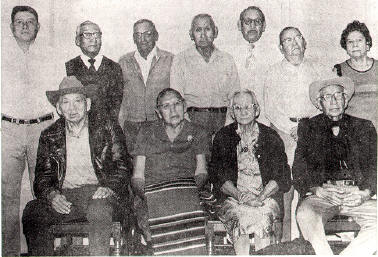|
|
Kaw
Even today, the Kaw display no particular concern over the fact that in 1673 French Jesuit Pere Jacques Marquette's map maker recorded them as the Kansa Indians, or that in 1861 the state of Kansas took its name from this first historical reference, without obtaining permission.
A Baptist missionary and former government surveyor reported in the 1830s, that the pronunciation of the natives themselves, was "Hau-zau." In conformity with this, a government interpreter in the 1890s reported that the Kaw called themselves Konza, with the second syllable scarcely audible. Hence the use of the name "Kaw." By the mid-19th century it was common practice for the Bureau of Indian Affairs to use "Kaw" in its official reports.
Two hundred years ago the Kaw lived near the confluence of what is today known as the Kansas and Missouria Rivers, in northeast Kansas. Conservative and resistant to change from tribal customs, they were a warlike people living mainly by buffalo hunting, though they grew small crops. The Kaw lived in dome-shaped, bark-covered homes.
The Kaw had been in existence for an immeasurable span of time when first observed in the mid 17th and early 18th centuries by the French at the present site of Kansas City. Spanish Conquistadors from the Southwest turned away from the area because of what they considered to be the harsh environment of the region. Even in the early 19th century, Major Stephen Long of the U.S. Army dismissed this land as "The Great American Desert." Today this area is commonly known as the "Breadbasket of the World."
The Kaw settled in Kansas and Nebraska until the 1820s, when they gave up their homeland under a series of treaties. In 1846, they moved to a reservation in Kansas and in 1872, sold their Kansas reservation to the United States, buying a reserve in Indian Territory from the Osage. After suffering deplorable conditions in Kansas, they arrived in Indian Territory. By 1904, the Kaws had agreed to accept allotments.
Many old, mixed-blood Kaw families bear French names, the result of intermarriage with early French traders. Today the admixture of French blood among the Kaw is large. There are only two remaining fullbloods in the Kaw Nation, Johnny Ray McCauley of Ponca City, Oklahoma, and William A. Mehojah, of Phoenix, Arizona.
Today the Kaw Nation is located in north central Oklahoma, specifically in Kay County. Of the 2,084 tribal members, about 25 percent reside in and around Kay County. Tribal business operations affecting the tribal constituency are conducted daily at the tribal headquarters in Kaw City, Oklahoma. The Kaw Nation is a very progressive and stable Indian nation. It presently administers 35 tribal programs on behalf of its membership and Indians residing in the Kaw service area.
The Kaw hold an annual pow wow every August, near their tribal headquarters in Kay County.
Please note: This information was compiled from several sources. Much of it came from Oklahomas Federally-Recognized Indian Tribes put out by the Oklahoma State Department of Education in 1992. The article, entitled "The Kaw Tribe of Oklahoma: A Precious Breed," was written by Jo Ann OBregon, and lists as its sources The Kaw People and The Kansa Indians: A History of the Wind People, 1673-1873 by William E. Unrau, Wichita Kansas: Wichita State University.
Kaw Nation, P.O. Box 50, Kaw City, OK 74647 580-269-2552
Fax 580-269-2301 http://www.hit.net/~tribe

The last full-blood council of the Kaw Nation |
|
|
|
|
 Native American Nations
Native American Nations
